Karen Hesse’s Newbery Medal–winning Out of the Dust (1997) was one of the first novels in verse for young people. This unique form bridges the worlds of poetry and prose by combining the imagery and cadence of poetry with the narrative arc of prose, using rhymed couplets, tanka, and free verse. Although the very young may enjoy the stories in rhyme, older readers may enter and navigate the world of story as created in the verse novels.
Ages 4–8
Go Home Bay. Susan Vande Griek. Ill. Pascal Milelli. 2016. Groundwood/House of Anansi.
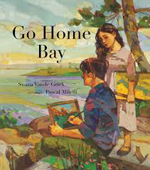 This quiet, lyrical narrative envisions the summer of 1914 when Canadian artist Tom Thomson visited Georgian Bay, Ontario. Invited by Dr. James MacCallum, a Toronto ophthalmologist, Tom spent part of his time there giving art lessons to 10-year-old Helen MacCallum. We witness the gentle unfolding of summer in free verse from Helen’s point of view: “He gives me oils and brush / and palette knife, / shows me how to petal them, / color them, shape them, / make them bloom on a little board.” Vibrant, bold oil on canvas double-page spreads help us see and feel what Helen experiences and are complemented by occasional pencil drawings on white backgrounds. A biographical note gives additional information and resources about Tom Thomson and includes a story about a small painting he gave to Helen, which she cherished throughout her lifetime. This is a welcome companion to Griek and Milelli’s The Art Room (2002) about another well-known Canadian artist, Emily Carr.
This quiet, lyrical narrative envisions the summer of 1914 when Canadian artist Tom Thomson visited Georgian Bay, Ontario. Invited by Dr. James MacCallum, a Toronto ophthalmologist, Tom spent part of his time there giving art lessons to 10-year-old Helen MacCallum. We witness the gentle unfolding of summer in free verse from Helen’s point of view: “He gives me oils and brush / and palette knife, / shows me how to petal them, / color them, shape them, / make them bloom on a little board.” Vibrant, bold oil on canvas double-page spreads help us see and feel what Helen experiences and are complemented by occasional pencil drawings on white backgrounds. A biographical note gives additional information and resources about Tom Thomson and includes a story about a small painting he gave to Helen, which she cherished throughout her lifetime. This is a welcome companion to Griek and Milelli’s The Art Room (2002) about another well-known Canadian artist, Emily Carr.
–LTP
Maxi the Little Taxi. Elizabeth Upton. Ill. Henry Cole. 2016. Scholastic.
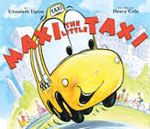 In rhyming couplets, Upton tells the story of Maxi’s first day on the job as a taxi. This anthropomorphic cab reflects the joys, delights, challenges, and fears a young child might experience in the course of a day. Maxi begins his day “flashy and bright” and enthusiastically zips and zooms around town and through every puddle he finds. Sticky fingers, ice cream, mustard, and pigeons leave their mark on him until no one wants to ride in a taxi as dirty as Maxi. A young boy comes to the rescue and suggests that Maxi should stop at a car wash. Although frightened at first, Maxi eventually enjoys the scrubbers and suds as “they tickled his muffler and bumper and hubs.” Maxi emerges shining as brightly as the streetlights and returns to the garage to be tucked in before drifting dreamily off to sleep. Perfect for reading aloud, the rhyming couplets propel the story along nearly as quickly as Maxi navigates the streets of the city, and Cole’s illustrations provide multiple perspectives with color choices that augment Maxi’s emotions.
In rhyming couplets, Upton tells the story of Maxi’s first day on the job as a taxi. This anthropomorphic cab reflects the joys, delights, challenges, and fears a young child might experience in the course of a day. Maxi begins his day “flashy and bright” and enthusiastically zips and zooms around town and through every puddle he finds. Sticky fingers, ice cream, mustard, and pigeons leave their mark on him until no one wants to ride in a taxi as dirty as Maxi. A young boy comes to the rescue and suggests that Maxi should stop at a car wash. Although frightened at first, Maxi eventually enjoys the scrubbers and suds as “they tickled his muffler and bumper and hubs.” Maxi emerges shining as brightly as the streetlights and returns to the garage to be tucked in before drifting dreamily off to sleep. Perfect for reading aloud, the rhyming couplets propel the story along nearly as quickly as Maxi navigates the streets of the city, and Cole’s illustrations provide multiple perspectives with color choices that augment Maxi’s emotions.
–LTP
Ages 9–11
Applesauce Weather. Helen Frost. Ill. Amy June Bates. 2016. Candlewick.
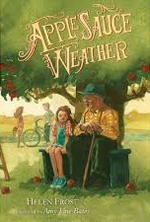 “Today is the day I've been waiting for: the first apple / fell from the tree.” So begins Faith’s introduction to her favorite time of the year. But this is the first year without Aunt Lucy. Will Uncle Arthur still visit and finish his tall tale about how he lost his finger? Faith has hope, but her brother, Peter, isn’t so sure. Faith, Peter, and Uncle Arthur all take turns moving the story along. Lucy’s songs, which reveal the family history behind the applesauce tradition, are interspersed throughout their poems. By the end of the novel, Faith realizes that she is blessed by the stories and songs in her life, “like an orchard of apple trees.” Helen Frost, winner of a Printz Honor for her verse novel Keesha’s House (2003), pens verses that resonate with emotion and rhythm. Amy June Bates’s black-and-white oil-based pencil illustrations bring this heartwarming tale to life.
“Today is the day I've been waiting for: the first apple / fell from the tree.” So begins Faith’s introduction to her favorite time of the year. But this is the first year without Aunt Lucy. Will Uncle Arthur still visit and finish his tall tale about how he lost his finger? Faith has hope, but her brother, Peter, isn’t so sure. Faith, Peter, and Uncle Arthur all take turns moving the story along. Lucy’s songs, which reveal the family history behind the applesauce tradition, are interspersed throughout their poems. By the end of the novel, Faith realizes that she is blessed by the stories and songs in her life, “like an orchard of apple trees.” Helen Frost, winner of a Printz Honor for her verse novel Keesha’s House (2003), pens verses that resonate with emotion and rhythm. Amy June Bates’s black-and-white oil-based pencil illustrations bring this heartwarming tale to life.
–LDP
Garvey’s Choice. Nikki Grimes. October 2016. Wordsong/Highlights.
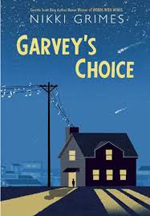 Garvey loves reading and astronomy, but his father expects him to be an athlete. After turning to food for comfort, his classmates and his sister bully him because of his weight. Garvey’s love of music proves to be a lifeline after his good friend encourages him to join the school chorus, and his outstanding tenor voice ultimately connects him to his father. Each poem in this novel in verse is a tanka, a traditional Japanese form of five lines. Nikki Grimes respects the form’s focus on mood while extending it to center on story. A recipient of the Virginia Hamilton Literary Award, the NCTE Award for Excellence in Poetry for Children, the Coretta Scott King Author Award for Bronx Masquerade (2003), and five additional Coretta Scott King Author Honors, Grimes does not disappoint with this latest offering. In a field dominated by books about girls and body type, Garvey’s Choice provides a realistic and honest portrayal of an overweight male finding his place in the world.
Garvey loves reading and astronomy, but his father expects him to be an athlete. After turning to food for comfort, his classmates and his sister bully him because of his weight. Garvey’s love of music proves to be a lifeline after his good friend encourages him to join the school chorus, and his outstanding tenor voice ultimately connects him to his father. Each poem in this novel in verse is a tanka, a traditional Japanese form of five lines. Nikki Grimes respects the form’s focus on mood while extending it to center on story. A recipient of the Virginia Hamilton Literary Award, the NCTE Award for Excellence in Poetry for Children, the Coretta Scott King Author Award for Bronx Masquerade (2003), and five additional Coretta Scott King Author Honors, Grimes does not disappoint with this latest offering. In a field dominated by books about girls and body type, Garvey’s Choice provides a realistic and honest portrayal of an overweight male finding his place in the world.
–LTP
Little Cat’s Luck. Marion Dane Bauer. Ill. Jennifer A. Bell. 2016. Simon & Schuster.
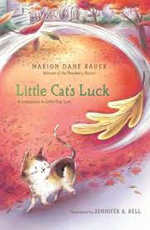 Patches, a little housecat, longs for a special place of her own. She embarks on a grand adventure, one that begins with the chasing of a golden leaf. She encounters a host of friends and foes along the way. At the end of her adventures in the wide world, she discovers that her special place is actually with Gus, a misunderstood dog, and his “special heart.” Gus creates an unlikely family with Patches and her three kittens, whom he watches over and protects. Jennifer Bell’s black-and-white illustrations were rendered in pencil and digitally produced. Newbery Honor winner Marion Dane Bauer is also the author of the verse novel: Little Dog, Lost (2012), a companion book to Little Cat’s Luck. –LDP
Patches, a little housecat, longs for a special place of her own. She embarks on a grand adventure, one that begins with the chasing of a golden leaf. She encounters a host of friends and foes along the way. At the end of her adventures in the wide world, she discovers that her special place is actually with Gus, a misunderstood dog, and his “special heart.” Gus creates an unlikely family with Patches and her three kittens, whom he watches over and protects. Jennifer Bell’s black-and-white illustrations were rendered in pencil and digitally produced. Newbery Honor winner Marion Dane Bauer is also the author of the verse novel: Little Dog, Lost (2012), a companion book to Little Cat’s Luck. –LDP
Somewhere Among. Annie Donwerth-Chikamatsu. 2016. Caitlyn Dlouhy/Atheneum/Simon & Schuster.
 Eleven-year-old Ema lives in Tokyo, Japan, with her Japanese father and American mother and identifies as binational, bicultural, bilingual, and biracial. She feels even more like a foreigner in her home country when she and her pregnant mother spend the summer and fall with her fierce obaasan and gentle jiichan rather than traveling to the United States to visit Grandpa Bob and Nana. The first person, free verse poems provide an intimate look at Ema’s life as she negotiates her place within her two very different worlds. Japanese culture and language are seamlessly woven into the narrative storyline in which Ema fears for the safety of her mother and her unborn sibling, misses her father—who must work in Tokyo—observes the lasting effects of WWII on her jiichan, overcomes bullying at her new school, and experiences the international reverberations of the 9/11 attacks in the United States. Ema ultimately comes to understand gangatte: how to endure with strength, effort, and patience.
Eleven-year-old Ema lives in Tokyo, Japan, with her Japanese father and American mother and identifies as binational, bicultural, bilingual, and biracial. She feels even more like a foreigner in her home country when she and her pregnant mother spend the summer and fall with her fierce obaasan and gentle jiichan rather than traveling to the United States to visit Grandpa Bob and Nana. The first person, free verse poems provide an intimate look at Ema’s life as she negotiates her place within her two very different worlds. Japanese culture and language are seamlessly woven into the narrative storyline in which Ema fears for the safety of her mother and her unborn sibling, misses her father—who must work in Tokyo—observes the lasting effects of WWII on her jiichan, overcomes bullying at her new school, and experiences the international reverberations of the 9/11 attacks in the United States. Ema ultimately comes to understand gangatte: how to endure with strength, effort, and patience.
–LTP
Ages 12–14
Falling Into the Dragon’s Mouth. Holly Thompson. 2016. Henry Holt.
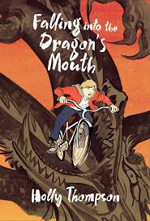 Jason Parker’s American family lives in the seaside village of Kamajura, Japan, where his weekly activities (from best to worst) include aikido, weekend hikes, English group, Friday soccer, babysitting his younger sister, tutor time, and—last and worst—school or “The Dragon’s Mouth.” Jason is “the nail that sticks out just waiting to be hammered down,” and the hammering begins when his class forms hans: table groups who sit, study, and do cleaning chores together. Jason meets verbal and physical abuse by drawing on his aikido training and holding his center. Although his teacher turns a blind eye and a friend betrays him, Jason finds strength and safety in the elder Takemura-san, school dropout Daiko, and the dojo. A neighborhood fire and coastal typhoon foreshadow the danger in which Jason finds himself as the bullying escalates to a choking game that nearly kills him. Japanese words and culture are seamlessly integrated in this first person, free verse novel that includes occasional brush-and-ink illustrations, a glossary, a cultural guide, and further resources.
Jason Parker’s American family lives in the seaside village of Kamajura, Japan, where his weekly activities (from best to worst) include aikido, weekend hikes, English group, Friday soccer, babysitting his younger sister, tutor time, and—last and worst—school or “The Dragon’s Mouth.” Jason is “the nail that sticks out just waiting to be hammered down,” and the hammering begins when his class forms hans: table groups who sit, study, and do cleaning chores together. Jason meets verbal and physical abuse by drawing on his aikido training and holding his center. Although his teacher turns a blind eye and a friend betrays him, Jason finds strength and safety in the elder Takemura-san, school dropout Daiko, and the dojo. A neighborhood fire and coastal typhoon foreshadow the danger in which Jason finds himself as the bullying escalates to a choking game that nearly kills him. Japanese words and culture are seamlessly integrated in this first person, free verse novel that includes occasional brush-and-ink illustrations, a glossary, a cultural guide, and further resources.
–LTP
The Lonely Ones. Kelsey Sutton. 2016. Philomel/Penguin.
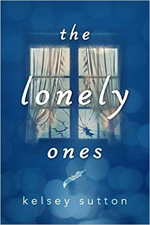 Fain’s world is dominated by arguing parents, distracted siblings, and bullying peers. In the absence of attention from family and friends, she finds comfort in creating fantastical stories of creatures—creatures that come out at night searching for lonely children like her. Fain escapes into this invented world rather than facing the reality of her lonely life. She writes the stories of these imaginary beings—sometimes it is difficult to tell if they are monsters or friends. When a teacher recognizes her talent and encourages her to enter a writing contest, Fain begins to embrace the possibility of creating a life in the real world. When she wins, the experience leaves her no longer feeling quite so invisible. As Fain begins to connect with her siblings and classmates, the monsters recede, and she is faced with making a difficult choice between remaining queen to the creatures of her imaginary world, or risking life in the real world. Kelsey Sutton expertly and eloquently uses the poetic form of free verse to explore themes of imagination, isolation, and friendship.
Fain’s world is dominated by arguing parents, distracted siblings, and bullying peers. In the absence of attention from family and friends, she finds comfort in creating fantastical stories of creatures—creatures that come out at night searching for lonely children like her. Fain escapes into this invented world rather than facing the reality of her lonely life. She writes the stories of these imaginary beings—sometimes it is difficult to tell if they are monsters or friends. When a teacher recognizes her talent and encourages her to enter a writing contest, Fain begins to embrace the possibility of creating a life in the real world. When she wins, the experience leaves her no longer feeling quite so invisible. As Fain begins to connect with her siblings and classmates, the monsters recede, and she is faced with making a difficult choice between remaining queen to the creatures of her imaginary world, or risking life in the real world. Kelsey Sutton expertly and eloquently uses the poetic form of free verse to explore themes of imagination, isolation, and friendship.
–LDP
Linda T. Parsons is an associate professor in the Department of Teaching and Learning on the Marion Campus of The Ohio State University, where she specializes in middle childhood literacy and young adult literature. Lisa D. Patrick is a literacy coach trainer at The Ohio State University’s Literacy Collaborative, where she specializes in children’s literature and early literacy.
These reviews are submitted by members of the International Literacy Association's Children's Literature and Reading Special Interest Group (CL/R SIG) and are published weekly on Literacy Daily.